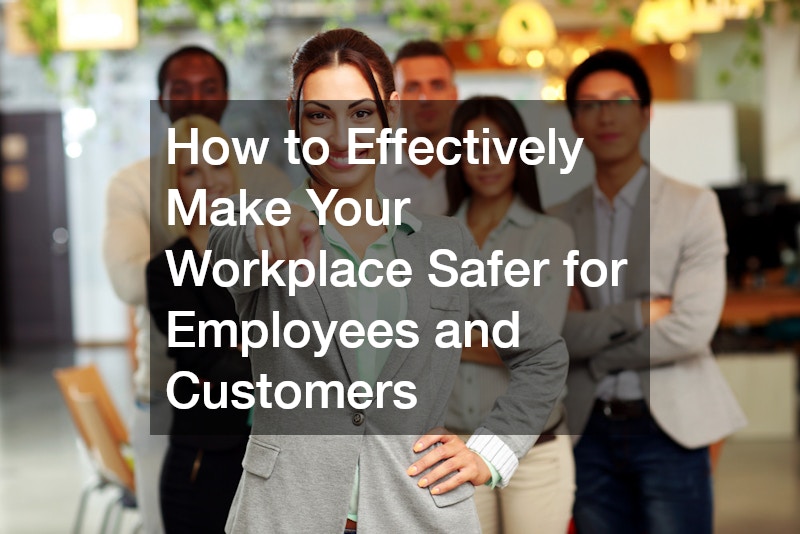
Creating a safe workplace is an essential responsibility for every organization. When employees and customers feel protected, productivity rises and satisfaction deepens. A robust safety strategy tackles potential hazards before they cause harm, weaving best practices into daily routines. From structural improvements to procedural upgrades, safety measures must be comprehensive and consistent.
In today’s rapidly evolving work environments, hazards can range from slips and falls to electrical risks and water damage. Addressing these challenges requires collaboration among facility managers, external experts, and frontline staff. By prioritizing risk assessment, targeted maintenance and continuous training, businesses can build resilience against common threats. The following sections outline practical steps to transform your workplace into a safer, more compliant environment.
Conduct a Comprehensive Safety Assessment
Begin your safety journey with a detailed audit of the facility’s physical and procedural aspects. Walk through every area—offices, restrooms, storage rooms and exterior spaces—looking for potential risks. Document uneven floors, blocked exits and outdated signage to inform your action plan.
Engage employees in the assessment process to tap into frontline observations. Their daily experiences often reveal subtle hazards, such as poorly lit corridors or malfunctioning door hardware. By involving team members, you foster a shared commitment to safety and ensure no blind spots remain.
Implement Regular Office Cleaning Routines
A clean workspace mitigates health risks and prevents accidents. Establish a daily office cleaning schedule that covers dusting, trash removal and sanitizing high-touch surfaces. Consistent upkeep reduces the buildup of allergens and pathogens, safeguarding respiratory health.
Partner with professional custodial staff or reputable vendors to ensure thorough disinfection. A focus on deep-cleaning carpets and upholstery every quarter complements daily efforts. By standardizing these routines, your organization maintains a hygienic environment that supports both morale and safety.
Enhance Fall Prevention with Anti-Slip Solutions
Slips and trips rank among the leading causes of workplace injuries. Identify high-traffic areas prone to moisture or debris accumulation, such as entryways and break rooms. Apply anti-slip mats and clearly mark transitions between floor types to guide safe footing.
Supplement matting with floor cleaning protocols that promptly address spills. Train staff to cordon off wet areas and deploy warning signs until surfaces dry. These simple interventions dramatically reduce the likelihood of falls, fostering confidence among employees and visitors alike.
Strengthen Support Structures with Stair Railings
Robust stair railings are vital wherever stairways are present. Inspect handrails for loose fittings, rust or splintering to guarantee stability. Regulations often mandate rail height and grip standards; ensure your installations comply with local building codes.
Consider adding mid-rail supports or extending handrails for greater coverage. Properly anchored, well-maintained railings aid balance and prevent dangerous overreaches. Regular lubrication of joints and hardware checks keep the system safe and reliable.
Optimize Lighting and Window Management
Adequate illumination is crucial for hazard visibility. Evaluate light levels in workstations, corridors and outdoor approaches during different times of day. Replace aging bulbs with energy-efficient LEDs that offer consistent brightness and cost savings.
Strategic placement of motion sensors and emergency backup lights enhances preparedness during power failures. Clear, well-lit signage for exits and stairwells ensures everyone can navigate the premises safely, even under stress or in reduced visibility.
Maintain Climate Control with Window Blinds
Installing window blinds helps regulate glare and heat gain in sun-exposed zones. Adjustable slats allow occupants to fine-tune natural light, reducing eye strain and limiting hotspots near workstations. Properly mounted blinds also prevent direct sun from fading upholstery or flooring.
Schedule blind cleaning and functionality checks twice a year to remove dust and verify smooth operation. Broken or bent slats can catch or shatter, posing laceration risks. Well-kept window treatments support comfort and safety throughout the building.
Preserve Roof Integrity with Professional Oversight
A sturdy roof shields the interior from weather-related hazards. Engage roofing companies to inspect shingles, flashing and gutters at least once annually. Early detection of leaks or loose materials prevents water infiltration that can damage ceilings and create slip risks below.
Choosing qualified installers guarantees that repairs or replacements adhere to manufacturer guidelines. High-quality membranes and sealants extend service life while minimizing maintenance calls. An investment in proactive roof care safeguards both assets and personnel.
Safeguard Against Water Hazards with Plumbing Service
Leaky pipes and clogged drains often precede slippery floors and mold growth. Retain a licensed plumbing service provider to perform routine inspections of valves, joints and fixtures. Timely repairs avert burst pipes that could flood work areas and disrupt operations.
Complement these checks with moisture-monitoring devices in vulnerable zones, such as basements or restrooms. Early alerts trigger swift responses from onsite teams or specialist vendors. This combination of vigilance and expertise helps maintain a dry, secure environment.
Address Flood Risks with Local Water Damage Companies
When water incidents occur, rapid remediation is critical. Establish relationships with local water damage companies that offer 24/7 emergency response. Their advanced extraction equipment and drying techniques limit structural and microbial damage.
Document a clear contact protocol so staff can summon experts immediately. Quick intervention reduces repair costs and prevents prolonged closures. A reliable restoration partner is a cornerstone of your broader safety and continuity plan.
Upgrade Electrical Systems with Certified Electrician Companies
Faulty wiring and overloaded circuits pose serious fire and shock risks. Schedule routine inspections by accredited electrician companies to test breakers, outlets and grounding systems. Comprehensive assessments identify outdated components before they fail catastrophically.
Implement surge protection for sensitive equipment and label panels for easy identification during emergencies. Training designated personnel on basic electrical shutdown procedures enhances readiness and minimizes panic in critical moments.
Control Solar Heat and Glare with Commercial Window Tinting
Excessive sunlight can strain vision and heat interior surfaces. Opt for commercial window tinting to block UV rays while preserving visibility. Tinted films improve energy efficiency by reducing cooling loads and shading sensitive equipment.
Select high-performance coatings suited to your building’s orientation and climate. Professional installers ensure uniform application without bubbles or peeling. Well-chosen tints contribute to occupant comfort and protect furnishings from sun damage.
Manage Outdoor Hazards through Landscaping
Exterior grounds are often overlooked but can harbor trip and collision risks. Level uneven pavements, fill potholes and clearly demarcate pedestrian paths. Botanical screening can guide foot traffic away from vehicular zones, enhancing safety.
Maintain drainage systems to prevent pooling near entrances, reducing slip hazards during rain events. Regular landscape reviews should assess root growth that may heave sidewalks or disrupt walkways, keeping outdoor transit areas secure.
Mitigate Tree-Related Risks with Local Tree Removal
Overhanging branches and diseased trees can jeopardize safety in storms. Employ local tree removal specialists to prune or remove hazardous growth. Certified arborists assess structural integrity and recommend interventions that preserve landscape health.
Effective pruning also enhances visibility around parking lots and access roads. By eliminating deadwood and weak limbs, you reduce the likelihood of falling debris. A proactive tree management plan balances aesthetics, environmental impact and workplace safety.
Prepare for Emergencies and Educate on Workers Compensation
All workplaces should have clear emergency protocols—from fire drills to medical incidents. Train staff on evacuation routes, first-aid stations and communication hierarchies. Post visible plans in common areas and conduct quarterly drills to reinforce procedures.
Ensure that your workers compensation policies are transparent and accessible. Familiarize employees with reporting processes and benefits in case of injury. A supportive approach encourages timely incident reporting, reducing downtime and fostering trust.
Foster Continuous Improvement and Safety Culture
Safety is not a one-time project but an ongoing commitment. Create cross-functional teams to review incident data, solicit feedback and update protocols. Celebrate milestones—such as accident-free quarters—to reinforce positive behaviors.
Provide regular refresher training on topics like slip prevention, electrical safety and emergency response. Recognize employees who suggest viable safety enhancements. Cultivating a proactive culture turns every team member into a stakeholder in workplace wellbeing.
Creating a truly safe workplace means weaving preventive measures into everyday operations. When you maintain a disciplined office cleaning regimen, you eliminate hidden hazards before they emerge, fostering an atmosphere where everyone can focus on their work without distraction.
Structural integrity is equally vital. Well-installed stair railings provide steady support and reduce fall risks, making stairways dependable routes rather than potential danger zones.
Beyond physical fixtures, having trusted service partners ensures systems run smoothly. Engaging experienced electrician companies for routine inspections keeps electrical circuits reliable, while timely checks by a dedicated plumbing service prevent leaks that could create slippery conditions or promote mold growth.
Cultivating a culture of safety also means preparing for the unexpected. Establish relationships with local emergency responders—such as local water damage companies—so you can act swiftly if flooding or moisture issues arise. Encourage employees to report near-misses and recognize proactive suggestions to continuously refine protocols.
By focusing on these pillars—cleanliness, structural soundness, professional maintenance and a responsive safety culture—you’ll build a workplace where both employees and customers feel secure. The result is not only fewer incidents but also a resilient environment that supports well-being and productivity over the long term.



